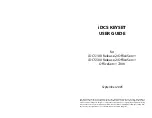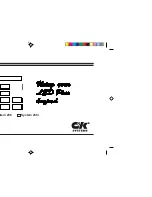
Using the vAE
12
MEDIUM AUDITORIUM
A modest-size auditorium with 750 to 900 seats. These types of auditoriums are
found in high schools, college campuses, churches, and as civic facilities in many
communities. The medium auditorium is modeled after a space with hard walls
and ceilings with absorption on the back wall to prevent strong reflections back
to the stage. The room has a small proscenium stage with additional reflective
surfaces located on the sidewalls in the ceiling area near the stage to improve early
reflections and diffusion. The sound character of this space is a bright clear sound
with a modest decay in the sound.
LARGE AUDITORIUM
A large space with 1,200 to 1,500 seats. These types of auditoriums are common
in larger high schools, college schools of music, larger churches, performing arts
centers, and civic facilities. It’s modeled with hard walls and ceilings, carpeted aisle
ways, padded seating, and absorption on the back wall to prevent strong reflections
back to the stage. The room has a large proscenium stage with sidewalls contain-
ing wood diffusing surfaces and additional reflective surfaces in the ceiling area
near the stage. Characteristics of this space include a warm, enveloping sound yet
still maintaining good clarity to the sound. There is a noticeably longer decay of
sound.
CATHEDRAL
Large, rectangular stone cathedral with highly reflective stone walls along the
sides providing early reflections. High ceilings and a long sanctuary contribute to
a quick buildup of sound with a long decay. Choral, organ and soloists playing
instruments with smooth attacks are highlighted in this room.
ARENA
Very large space with seating for 10,000. The space is modeled after typical indoor
sports facilities found on larger college campuses and in larger cities. The charac-
teristic sound of these spaces is dominated by hard surfaces with little absorption.
Sidewalls are located some distance away, creating early reflections that are notice-
ably delayed. Sound decays very slowly in these types of spaces due to the size and
larger area of hard reflecting surfaces.
ADjUSTING vOLUME
Press the Volume UP/DOWN buttons to adjust the volume as desired. This is normally
only necessary for playback of your sessions as the volume level is preset for each per-
formance space. There may be some cases when practicing with loud instruments that
you may want to turn the volume down. These buttons only affect the volume level of
playback if pressed during playback. If pressed when playback is stopped, they change
the volume of the Active Acoustics.
MUTE
Press the MUTE button to toggle on or off the Active Acoustics of the system. The cor-
responding LED shows if the sound of the Active Acoustics is off. When playback is
started, the Active Acoustics is automatically muted to avoid double reverberation, but
can be un-muted manually if desired.
Summary of Contents for VAE
Page 1: ...User s Guide Lexicon technology ...
Page 17: ...17 ...
Page 18: ...18 ...
Page 19: ...19 ...






































